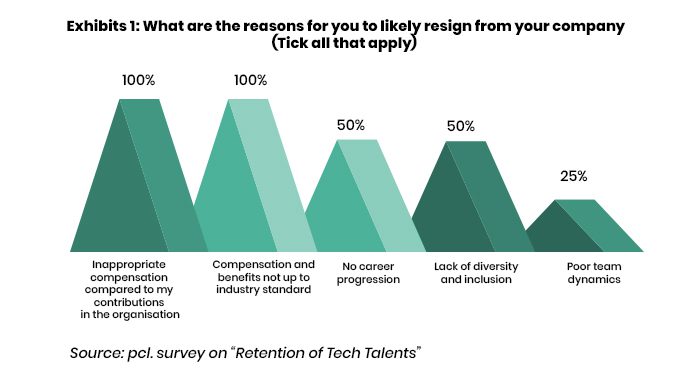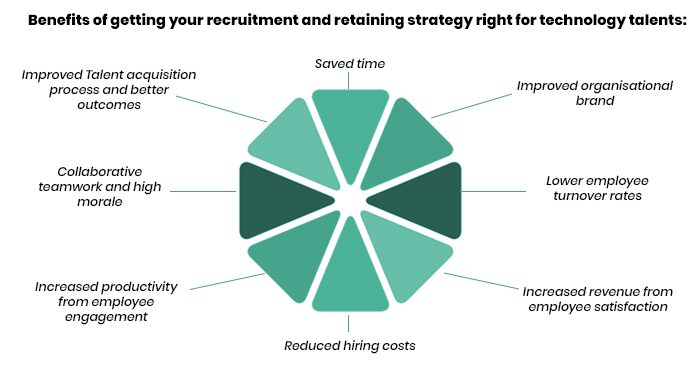Organisations in Nigeria are struggling to attract and retain top technical talents to drive their digital transformation agenda and meet current business demands. A recent survey conducted by pcl. on Retention of Tech Talents across organisations has revealed.
COVID 19 came with enormous responsibility on IT practitioners to adapt to changing work models and operating requirements to meet safety and regulatory conditions. As organisations undergo digital transformations, they need to effectively attract employees with the requisite skills to apply new technologies and digital services and an agile and adaptive workforce to navigate the changes.
Increasingly, young professionals are finding themselves drawn to tech firms or innovative startups. This poses a challenge to what traditional organisations can match in terms of the required creativity and opportunities to readjust digital demands and possibilities. The future of most organisations will likely be different from its past in terms of the technology, processes, talent and strategies to compete in new value pools and markets.
The evolution of AI and emerging technologies are potentially replacing several back-office jobs. Also, the redesigning of existing technologies is creating new ways of doing things, demanding new skills and competencies and emphasising the ability to rapidly develop and diffuse a range of professional skills across the organisation. Today, companies face forces of change whose velocity and impact are more significant than anything they have experienced before. Digital technology is disrupting the traditional business models and competitive sets while also providing a pathway to improvements in productivity and cost-effectiveness. As rising costs and emerging competitors pressure traditional organisations, they will need to look to new sources of growth and profitability.
These forces represent complex challenges and great opportunities for those companies that can anticipate and adapt to change. HR must play a vital role in acquiring and developing the talent required to move forward while ensuring that companies align their organisational structures, policies and talent management strategies with the demands of a changing business environment.
Winning the battle for technology talents retention
Retention is part of the critical challenges Technology leaders, and Human Resource teams encounter in today’s world of work. Employees exit organisations for various reasons like getting a new job offer, advanced degree, relocation, retirement, working with a demanding boss, or even an involuntary exit.
To better understand the trends and dynamics of tech talents retention, pcl. recently conducted a survey to analyse the underlying factors why the attrition rate for technology talents is high across industries. Through the analysis, we identified that technology experts or employees would remain with an organisation due to competitive compensation and benefits, work conditions, developmental opportunities, and career progressions (Exhibit 1)
Today, turnover or attrition rate is critical for organisations, considering the cost implications of the talent acquisition process (time and cost for advertising the vacant role or roles, candidate sourcing, shortlisting, screening). Sometimes, it takes new talents months or years to become as productive as those they replaced.
Businesses focusing on employee retention have more reliable results and various accumulations. They also tend to preserve their talented, active, and inspired employees who genuinely want to be a part of the company and contribute to its vision.
Globalisation is also forcing Tech Talents to want to be at the top of the niche they have tagged for themselves. Today, the tech workforce is primarily dominated by millennials who want to evolve, progress as the best in their career and benchmark against those within the local and international environments.
To address this, Human Resources cannot stand aloof any longer in a bid to keep the tech talent. A conscious and deliberate effort should be encouraged to understand the world of Tech talents, identifying their roles and the competencies that will drive the business and strategic objectives.
Benefits of getting your recruitment and retaining strategy right for technology talents:
Hiring practices to close the tech. talents gap
1. Start retention from the Talent Acquisition stage.
Talent acquisition plays a very significant role when it comes to retention. A recruiters’ strategy and how they showcase or speak about their organisation’s brand, values, and vision significantly impact what happens afterwards.
A talent acquisition process with all activities related to it needs a well-thought-out plan for a positive outcome. When a candidate has a positive experience from recruitment, it can transform into a positive employee experience in time. Recruiters should take charge of the first impression and build a solid ground for future success.
2. Flexible/Remote Work
The workplace has advanced over time in the use of technology. Technology organisations should invest in flexible work because it is not cost-effective as their talents need just a working device and WiFi connection to fulfil their daily assignments.
According to a survey by Globalisation Partners on remote work, they found out that 63% of global firms are considering making remote work a “permanent fixture” following COVID-19, where employee sentiment reveals that offering remote working could boost talent retention.
The survey also found that 48% of employees feel happier about their work since they began working remotely. 44% of respondents plan to stay more than five years at their current job. Considering that 48% of employees feel happier about their careers since working remotely, creating a remote work policy could help companies retain talent in the long term. Technology companies that support remote work are more likely to draw in top talent quickly, even if they occasionally offer work-from-home opportunities. Flexible working hours help produce a better work-life balance, boosting productivity, motivation, employee satisfaction, and healthier employees.
3. Training and Developing Talents
When an organisation’s focus includes training and development, it ultimately helps them address the retention rate in their workplace.
Training and developing talents is an investment that will produce long-term satisfaction to employees. When employees gain new skill sets and competencies, it becomes a win-win for the organisation and the talents who see a clear career advancement path, feel content, accomplished, and ultimately positively impact the organisation. New technical competencies are in high demand for technology talents as they evolve rapidly. Restricting an employee by offering a career path that doesn’t have much room to grow causes technology talents to leave.
4. Employee compensation
Organisations must make their employee compensation competitive; This means employers need to evaluate and review salaries regularly. Even if the business can’t afford an increase yet, there should be a consideration in providing other forms of compensation, like bonuses. Also, improvement in health care and retirement plans can help raise employees’ job satisfaction levels.
Building the tech talents pipeline
The challenges of attracting and retaining the best talents for organisations in Nigeria are indeed many and varied. From struggling with an image problem to competing internationally, to the falling value of the Naira, to competing with agile FinTech startups and African tech giants hiring for remote work, companies in Nigeria have their work cut out if they are to bring in the right people and successfully achieve their digital strategies. Many of the tech-savvy talents in Nigeria are particularly interested in working remotely, preferring international hires and earning in higher currencies.
As technology and broader employment trends reshape the business world, organisations need to align their workforce transformation to attract enthusiastic young tech talents with the ultimate goal of earning big paychecks and making a great impact.
Written by:
 |
 |
 |
| Jason Ikegwu
Associate Partner |
Ruth Pelemoh
Analyst |
Oludiji Lana
Enterprise Solutions Architect |


